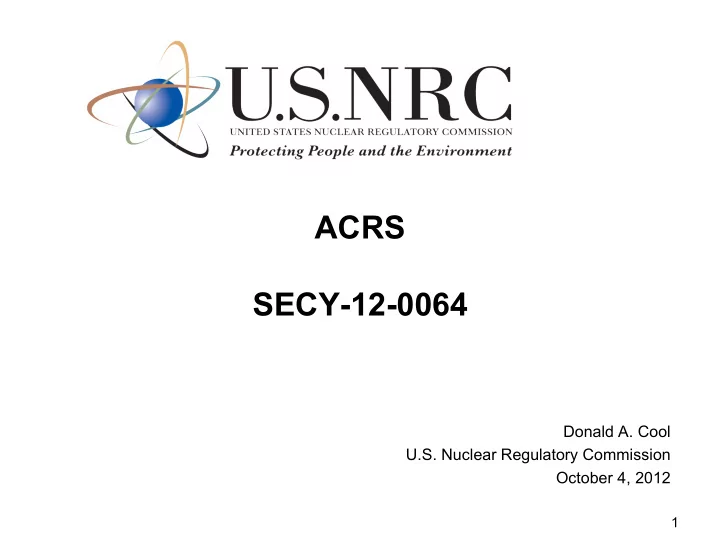

ACRS SECY-12-0064 Donald A. Cool U.S. Nuclear Regulatory Commission October 4, 2012 1
Presentation Outline • Background • Risk • Occupational Exposure Data • Regulatory Approaches Considered 2
Background • SECY-12-0064, April 25, 2012 • Staff met with ACRS Subcommittee on Radiation Protection and Nuclear Materials on April 27 and September 18, 2012 • Staff met with ACRS on June 6, 2012 3
Regulation Risk Basis • 10 CFR Part 20 Occupational Dose limits based on assumed risk of 1.25 x 10 -2 per Sv cancer mortality and risk of heritable disease • Current radiation risk ≈ 5x10 -2 per Sv – Considered mortality, morbidity and hereditary effects – Comparable results from UNSCEAR, ICRP, BEIR, NCRP – EPA “Blue Book” values for U.S. Population Incidence: 1.16 x 10 -1 (5.6 x 10 -2 to 2.1 x 10 -1 ) Mortality: 5.8 x 10 -2 (2.8 x 10 -2 to 1.0 x 10 -3 ) 4
Selection of the Limit Value • 1977 – ICRP 26 – average annual risk of accidental death in industries generally accepted as safe working environment – 1 x 10 -4 – 5 rem value based on expectation that most individuals would be unlikely to exceed 1 rem • 1990 – ICRP 60 – Multi-attribute approach – Objective to prevent cumulative exposure to less than 100 rem (1 Sv) – Average and maximum values to provide flexibility for implementation 5
< 20 mSv = 99.57% NCRP Report 160 6
REIRS Data Individuals with Dose Greater than 2 rem 800 700 600 Number of Individuals 500 400 300 200 100 0 2000 2001 2002 2003 2004 2005 2006 2007 2008 2009 2010 Year * Data from NUREG-0713, Vol. 32; www.nrc.gov/reading-rm/doc-collections/nuregs/staff/sr0713/v32/ 7
Findings • For reported exposures, almost all exposures are below limits • Individual exposures occur each year in excess of ICRP recommended average • The number of individuals exceeding 2 rem each year is small 8
Findings • For the individuals at the high dose end of the distribution, multiple years of exposure can exceed recommended lifetime value • The person-rem total of higher dose individuals is small, because of the small number of individuals • By traditional regulatory analysis, little justification for changes 9
The Challenge • What is the most efficient and effective method to ensure that each individual is adequately protected? • Method must be clear, predictable, and reliable • Method must be applicable to all types of occupational exposures, for all types of uses 10
What did Staff Consider? • Strengthen ALARA • ICRP Recommended Average and Maximum Limit • Single Lower Dose Limit 11
Staff Conclusions • A change to limits is a more straight forward, performance based approach than additions to ALARA program requirements • Rulemaking would require designation of adequate protection and/or backfit justification on both quantitative and qualitative grounds 12
Staff Conclusions • Additional efforts will be needed to develop regulatory basis for a proposed rule – Explore possible draft rule text – Explore possible guidance for implementation – Dose coefficients needed before Appendix B values can be revised – Detailed cost-benefit information needed for specific proposals 13
Questions and Discussion 14
Recommend
More recommend